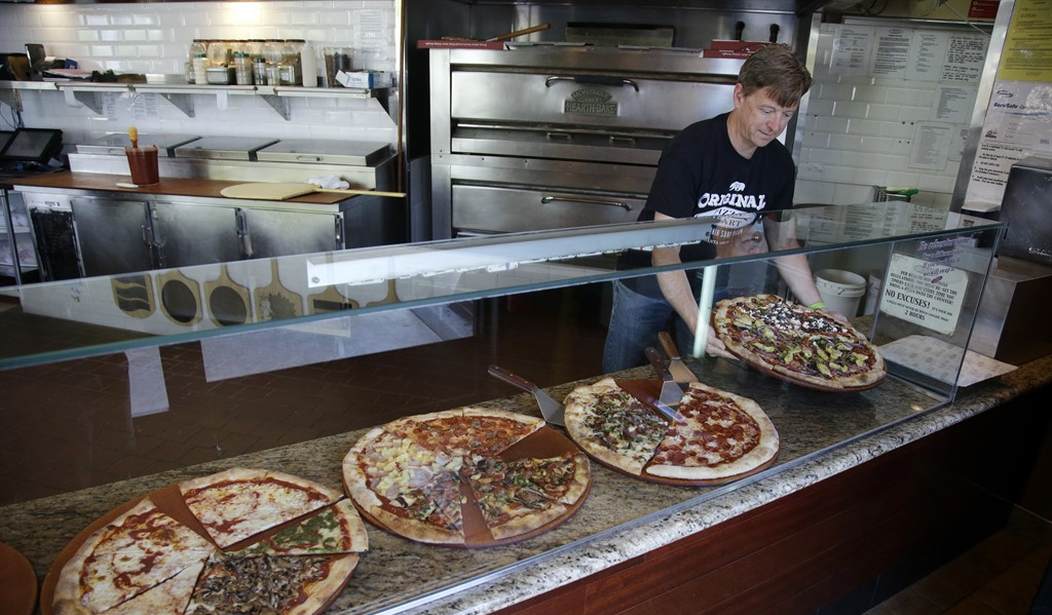Here is an anecdotal example of how this works in practice. I’m sure others have similar stories, and I dare anyone to show that this is the exception and not the rule.
A husband and wife who had been wage earners thru their 30’s while they had kids made a decision when the kids left that they wanted to try their hand as an entrepreneurial team, and started on a path that led them to operate a series of retail business establishments with varying degrees of success over the next 25 years. They never got rich, but they always had everything they needed, they made a lot of friends, and they had a lot of fun.
But when they reached their 60s they decided to wind down the businesses they had open, shuttering a couple and selling off a couple of others. With the accumulated capital they bought an ice cream parlor in an 85-year-old established commercial district less than a mile from where they lived. They named it after their only grandchild at the time. Their thinking was “What kid wouldn’t want to tell his friends that his grandparents owned an ice cream parlor?” After 10 years in business, although the couple had always been well-known in the community because of their other businesses, the ice cream parlor had become a bit of the social “center of gravity” in the “Old Town” neighborhood where it was located. When they were inducted into the business community’s Hall of Fame, it was estimated that they had employed over 200 high school kids in the ice cream parlor alone during the 10 years of operation — they only employed high school kids — and had donated about $25,000 worth of ice cream to various community functions over the years.
During the school year, they would employ 5-6 high school kids at a time, paying them minimum age for the first 6 months, and then giving them $.50 and $1 an hour raises the longer they remained working for the store. Most kids stayed from 12-18 months. In the summertime when business was heavier, they would employ 8-10 kids at a time. When they first opened, the minimum wage rate was $6.50. It then climbed sporadically over the years, and today it rests at $10.50.
When they first started out and were a bit younger, they would keep the store open in the summer from 10:00 am to 10:00 pm. The husband would arrive at 7:00 am to start the prep work — they also sold sandwiches — and had a “soft-open” at 7:30 am for anyone who just wanted coffee and oatmeal. They normally had 2 high school employees in the store from 10:00 to 12:00, 4 in the store from 12:00 to 8:00, and 2 in the store from 8:00 to 10:00. The average wage at that time was $7.50 an hour. So their “regular” daily gross wage cost was in the range of $300-$325 per day. Over a 31 day month, the gross wages — without taxes and benefits — was just under $10,000. But on top of that, they were obligated by law to pay 7.5% for each employee for FICA, as well as a premium for unemployment insurance based on their monthly gross labor costs.
The couple worked varying hours during the week — the husband worked in the mornings, leaving the store after the lunch business was done, and the wife came in at the tail end of the lunch business and stayed until the early evening. They would then come back together at 9:00 to close out the store for the day, help clean and lock up. They worked pretty much seven days a week. But it really wasn’t work — it was their work and social life rolled into one because a sizeable portion of their customers were friends.
For all this effort, they cleared a net profit of about $70,000 in a good year — about $6000 a month for both their efforts.
Then they were hit by a $1 an hour increase in the minimum wage.
When you translate that straight across to their workforce, it was a uniform increase of $1 dollar for every manhour they had a high school student working in the shop. In the summer, when business was at its best, that was usually around 1200 hours a month. So, without selling a single additional scoop of ice cream or an extra sandwich, their gross wage cost increased from $10,000 a month to $11,200 a month. When you include the higher FICA taxes — 7.5% of a higher wage rate — and the additional unemployment insurance which is based on gross monthly water, the total increase on a monthly basis was a little less than $11,700. Over the course of the first full year, total labor costs increased by about $20,000.
That money came from the $70,000 in profit that the couple — at that point in their early 70s — were getting for their labor and investment. Rather than $70,000, they realized a profit of about $50,000 — in a good year. That’s $25,000 each to run a business on a 7 day a week basis, 8+ hours a day.
They were ok. They had retirement income and savings. They operated the store as a labor of love.
But they did make one change for year two — they hired two fewer high school students because during the slower times of the year — the winter — the store struggled to simply break even every month. They worked a few more hours each week themselves to make up for it.
Then the minimum wage was increased again. And when the numbers were calculated, their labor costs related to the second increase were about $6000 higher than the year before, even with 2 fewer students as employees.
Like the previous year, they decided to hire one less high school student, and the couple worked more hours. But when the year was over, the net profit was down to under $45,000 — less than $20,000 each while now working 60+ hours a week.
Well, why not raise prices? They tried that — sales fell. They were selling ice cream — a luxury. There is a limit to how much you can expect a customer to pay before the customer decides to skip the indulgence.
The husband died the following year from cancer. The wife has continued to operate the store, reducing the store’s hours to 10 per day to reduce labor costs. The minimum wage in 2006 when they first opened was $7.50 an hour. Now she pays $13 to the high school students who work for her. In the winter she just tries to break even but usually loses a small amount each month. In the summer she makes a profit of about $1500 a month. That’s ok with her because she wouldn’t know what to do with her day if she didn’t have the store.
She employs only 2 high school students in the winter and 6 in the spring and summer. All because of increased labor costs.
But what if this was a business operated by couple in their 30s with two kids and a mortgage on their house?
It would have closed years ago, taken a job at $20 an hour with no risk, and all those high school kids would not have had their “entry-level” employment experience.
There’s your primer on the practical implications of the $15 an hour minimum wage on small business in America.














